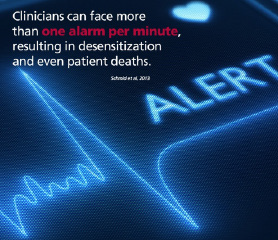Alarm Anthology: A Robust Collection of Knowledge
“ AAMI pulled together a cross-disciplinary team to develop an alarm compendium for hospitals and health systems as a best practices guide to help navigate the complexities of alarm management. The compendium gives real-world examples used by other hospitals that can be implemented to reduce alarms such as alarm reports, education and competencies, and applications of tools such as failure modes effect analysis. The compendium also provides default parameter settings for multiple facilities of varying sizes and complexities. ” —Samantha Jacques, PhD, FACHE, director of clinical engineering for the Penn State Health System, in TechNation |
A Call to Action: Deliverables from the Medical Device Alarm Summit 2011
Summit Report: Clinical Alarms
This summit report, Clinical Alarms, issues a call to action to address the challenges around alarm management. It includes:
- Seven clarion themes and 31 priority actions
- Top 10 actions you can take now
- Summaries of presentations, expert perspectives, and leading practices.
Beyond the Summit: AAMI Foundation Safety Innovations Series: 2012–16
- Plan, Do, Check, Act: Using Action Research to Manage Alarm Systems, Signals, and Responses: The Beth Israel Deaconess Medical Center,
Vockley, M. (2012)
Beth Israel Deaconess Medical Center responded to two alarm-related sentinel events by quickly identifying opportunities for short-term fixes to a multifaceted problem and then longer-term solutions and innovations. - Recommendations for Alarm Signal Standardization and More Innovation: The Christiana Care Health
System Experience, Vockley, M. (2012)
Christiana Care Health System developed a system-wide alarm policy and protocols that defined its alarm management strategy for alarmed medical equipment, including flex monitors, standard cardiac monitors, pulse oximeters, and infusion pumps. - Using Data to Drive Alarm System Improvements: The Johns Hopkins Hospital Experience,
Williams, J. (2012)
For Johns Hopkins Hospital, the key to reducing alarm signal noise is the collection and analysis of quantitative data to evaluate the applications of alarm system management in hospitals. - Cardiopulmonary Monitors and Clinically Significant Events in Critically Ill Children: Children’s National Medical Center, Talley,
L.B., Hooper, J., Jacobs, B., Guzzetta, C., McCarter, R., Sill, A., Cain, S., & Wilson, S.L. (2013)
A team of nurses, biomedical engineers, physicians, and biostatisticians were assembled to assess the conditions associated with the generation of cardiopulmonary monitors, including false positive alarm signals in critically ill children, and to define alternative alarm parameters that would improve alarm performance. - Safeguarding Patients with Surveillance Monitoring: The Dartmouth-Hitchcock Medical Center Experience,
Vockley, M. (2013)
A series of adverse events led clinicians and researchers at Dartmouth-Hitchcock Medical Center to a humbling conclusion: Healthcare professionals were handicapped by their limited ability to detect signs of patient deterioration and to predict which patients were at risk for adverse events in the first place. Dartmouth-Hitchcock responded with stopgap measures to safeguard patients, including double checks of opioid administration, smart patient-controlled analgesia pumps, and rapid response teams. The Dartmouth-Hitchcock team also developed alarm thresholds, notification delay time, and a system for alarm parameter adjustments. - Simple Solutions for Improving Patient Safety in Cardiac Monitoring—Eight Critical Elements to Monitor Alarm Competency,
Allen, J.S., Hileman, K., & Ward, A. (2013)
The University of Pittsburgh Medical Center (UPMC) is a large, multi-hospital system. Through pilot programs and trial and error, the healthcare system and UPMC Presbyterian Hospital sought to find commonalities in alarm management between different units. - Clinical Practice Changes Associated with Alarm Standardization: The Boston Medical Center Experience,
Lipschultz, A. (2014)
Boston Medical Center responded to national attention on alarm fatigue and reports of sentinel events from missed alarm signals by reconvening a multidisciplinary task force to look for opportunities to decrease the volume of audible alarms, particularly on its medical surgical units. - Healthcare Alarm Safety—What We Can Learn from Military Alarm Management Strategies,
Allen, J.S. (2014)
Daniel McFarlane of Lockheed Martin Advanced Technologies Laboratories provides insight on ways to enhance hospital alarm management, reflecting upon innovative alerting systems utilized by the Navy to improve warfighter awareness and capabilities. - Fighting Alarm Fatigue with Data-Driven Interventions: The NCH Healthcare Device Eco-System Experience, Epstein,
M.L., Smith, K., & Snavely, V. (2016)
NCH Healthcare System turned its attention to alarm management in response to The Joint Commission’s National Patient Safety Goals, using data to inform decisions on nonactionable tachycardia alarms.
Practical Strategies for Executives, Risk Managers, and Clinical Leaders: Deliverables from the AAMI Foundation’s National Coalition for Alarm Management Safety: 2015–18
Alarm Management Quick Guide—Managing Smart Pump Alarms: Reducing Alarm Fatigue (2018)
This guide provides a starting point for healthcare institutions to begin to explore their large-volume and syringe pump alarms and understand potential strategies to mitigate nonactionable alarms.
Practical Tools
Special Publication
Toolkit
- SpO2 Alarm Management Toolkit, Piepenbrink, J., & Sendelbach, S., (Eds.) (2018)
Spreading the Word
 Social media is key to informing all those who are concerned about patient safety that there are tools developed by national experts to assist in reducing harm with infusion therapy. Over the four years of this effort, AAMI and AAMI Foundation have
made use of Facebook and Twitter to get the word out about the recommendations and solutions available to the clinical community.
Social media is key to informing all those who are concerned about patient safety that there are tools developed by national experts to assist in reducing harm with infusion therapy. Over the four years of this effort, AAMI and AAMI Foundation have
made use of Facebook and Twitter to get the word out about the recommendations and solutions available to the clinical community.
Return to Table of Contents
